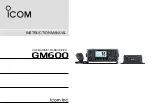
4
4
C
C
H
H
A
A
N
N
N
N
E
E
L
L
A
A
N
N
A
A
L
L
O
O
G
G
U
U
E
E
R
R
E
E
C
C
E
E
I
I
V
V
E
E
R
R
1
1
5
5
O
O
F
F
2
2
4
4
1
1
2
2
0
0
-
-
2
2
0
0
8
8
-
-
1
1
2
2
T
T
Y
Y
P
P
E
E
S
S
I
I
L
L
B
B
U
U
S
S
-
-
R
R
X
X
4
4
A
A
U
U
S
S
E
E
R
R
M
M
A
A
N
N
U
U
A
A
L
L
I
I
s
s
s
s
u
u
e
e
:
:
0
0
4
4
The above example shows the format of the command when the address is configured.
The keyword “SET” is required to invoke a change; the number of the RX4A output is
next, followed by the SILBUS channel address. If a RX4A output is not to be used then it
should not be assigned a SILBUS channel address. The keyword “DISABLE” is used
when a SILBUS channel is not required.
RX4A::>SBFALT SET 2 DISABLE
Setting Changed
Channel [1] Fault Address = J2
Channel [2] Fault Address = DISABLE
Channel [3] Fault Address = A7
Channel [4] Fault Address = B3
RX4A::>_
5.11 FAULT LEVEL COMMAND
This command is used to display and configure the under level fault trigger point for each
of the analogue outputs. The fault trigger point allows the analogue receiver to detect
output signals that are out of range (less than 4mA) or open circuit. The fault level is
entered as a mA level for example 3.80. This would cause a fault to be generated
whenever the output signal fell below 380mV for a 0.4 to 2.0V output signal or 3.80mA for
a 4 to 20mA signal. The current fault levels can be displayed by simply entering the
command name as shown in the example below:
TX4A::>FLTLEV
Output [1] = 3.99mA
Output [2] = 4.00mA
Output [3] = 3.90mA
Output [4] = 3.85mA
If the command name is entered with additional attributes the fault levels can be
configured to any valid level. An example of configuring the fault level for output 2 is
shown below:
TX4A::>FLTLEV SET 2 3.95
Setting Changed
Output [1] = 3.99mA
Output [2] = 3.95mA
Output [3] = 3.90mA
Output [4] = 3.85mA
5.12 FAULT HYSTERESIS COMMAND
This command is used to display and configure the under level fault trigger point
hysteresis for each of the analogue outputs. The hysteresis value is used to stop the fault
signal from switching on and off with any noise that may be present on the analogue
output signal. For example if the analogue output was currently at 4.00mA and the fault
level was set at 3.99mA, the output signal would only need slightly more than 0.01mA of










































